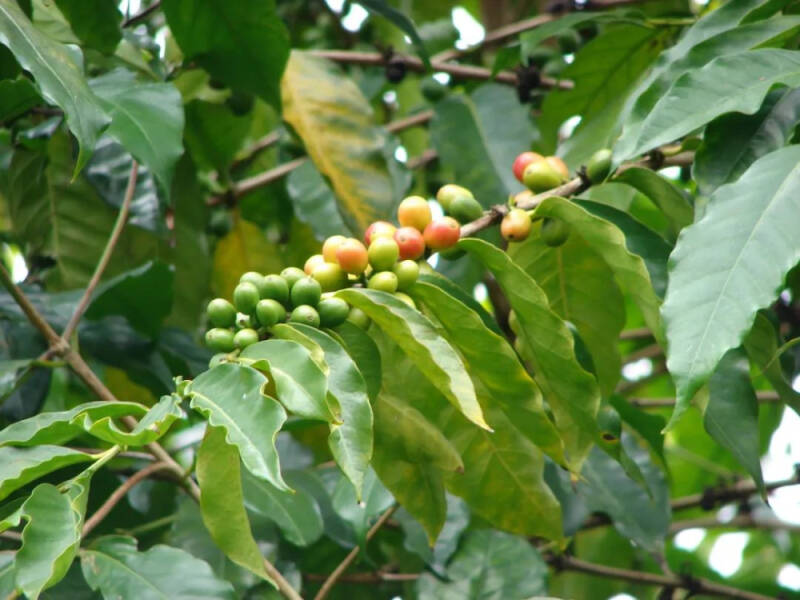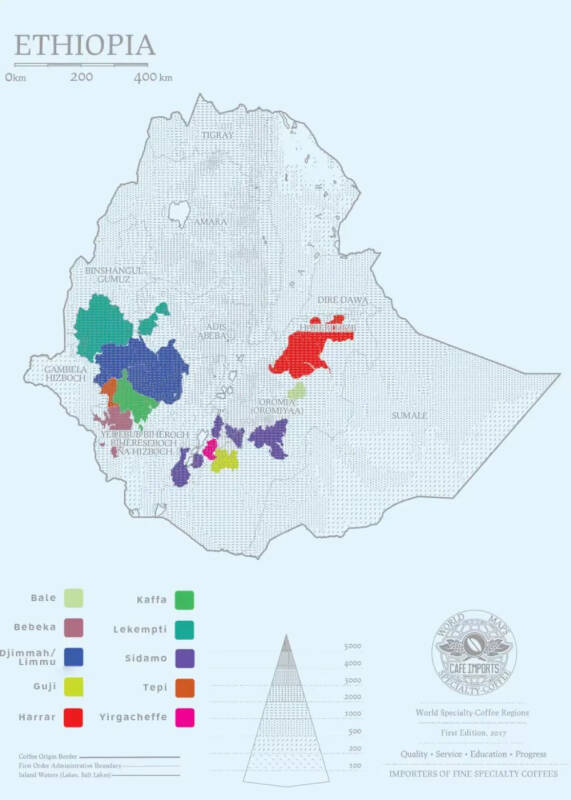Ethiopian Coffee beans | introduction of 74158 Coffee beans from Sita Veni processing Plant in Sidamo
In Africa, there are many coffee producing countries, including an ancient country with 3,000 years of civilization and recognized birthplace of coffee, that is Ethiopia. The name "coffee" also comes from the Kaffa Forest in southwestern Ethiopia, which is now an important coffee producer, the largest Arabica producer in Africa, and has more than 10,000 coffee varieties.
Ethiopia
Ethiopia, located in the center of the Horn of Africa and on the East African Plateau southwest of the Red Sea, is a landlocked country. It borders Djibouti, Somalia, Sudan, South Sudan, Kenya and Eritrea. The territory is dominated by mountain plateaus, most of which are Ethiopian plateaus, accounting for 2x3 of the country, and the East African Rift Valley runs through the whole territory, with an average elevation of nearly 3000 meters, which is known as the roof of Africa.

Affected by high altitude, Ethiopia has an average annual temperature of 16 ℃, which is roughly divided into dry season and rainy season. The country is rich in water resources and has nearly 50 volcanoes. Under the influence of volcanic ash, the fertile land, coupled with high-altitude mountains, suitable climate, Ethiopia has unique natural conditions to grow coffee.
Sidamo producing area
Ethiopia has many well-known coffee producing areas, such as Sidamo, Jima, Haller, Guji and Yirgacheffe. Qianjie Coffee has a washed Yejashefi coffee bean, as an entry selection, with jasmine, orange, berry fruit flavor, lemon acid, soft taste.

After 1995 Ethiopia adopted a federal system and the local government replanned according to the major ethnic settlements and languages out of respect for the culture of all ethnic groups in the country. In this way, Sidama was placed under the jurisdiction of the new Southern National language Autonomous Prefecture, which was renamed as the original historical name: Sidama. But at that time, in order to strengthen the promotion of the uniqueness of coffee in the country, the Ethiopian government applied for a patent for the names of three producing areas in 2004, choosing the old name Sidamo ®as the registration of Cedama Coffee. Until now, domestic consumers have always been used to calling the coffee here "Sidamo". Sidamo straddles the fertile highlands south of Lake Awasa in the Great Rift Valley of East Africa, with an elevation of 1400-2200m and an annual rainfall of 1200-2000 mm. High altitude, sufficient Rain Water, pleasant climate and rich geological nutrients provide an ideal environment for growing coffee.
Santa Vini processing plant
In the Sidamo area, there are many coffee processing plants, among which DWD is the more famous company in the Sidamo area, with 17 coffee processing plants and the largest number of Coffee processing plants in the Sidamo region. It has Gauss, Santa Veni and other processing plants. The Santa Vini processing plant, which is about 40 minutes from the town of Santa Veni, is one of DWD's high-altitude processing plants. The area where Santa Vini is located has a drier climate and lower average temperatures, so it takes longer to process coffee berries.
Digital variety
In Ethiopia, because there are too many varieties of coffee and it is difficult to distinguish, it is generally referred to as the original species or Heirloom. In recent years, some digital beans began to appear, such as 74110, 74112, 74158 and so on. These varieties are opened by the Jimma Agricultural Research Centre (JARC), one of the Federal Agricultural Research centres in Ethiopia, and are designed to improve resistance to pests and diseases and increase yields. JARC identified and planted 639 different coffee bean varieties in 15 regions from 1973 to 1975. Among these samples, a total of 13 beans performed well, with high yield, disease resistance, drought resistance and good flavor, so JARC classified these beans as "1974/1975CBD-Rexistent Selections". That is, the numbering series, and the common ones are 74110 and 74158. The first two digits, 74x75, refer to the year in which they were found, while the number after 74ap75 is the variety number.
Qianjie Coffee Sidamo Santavini 74158 Coffee Bean production area: Sidamo treatment Station: DWD Santa Veni treatment Plant altitude: 2050 m treatment: 96 hours anaerobic sun drying varieties: 74158 flavor: fermented wine pineapple citrus tropical fruit red wine
Qianjie Coffee beans this Ethiopian Santavini Coffee beans use 96 hours of anaerobic sun, light baking, Qianjie uses V60 beverages 1 ℃ 15%, 92 ℃ to cook, after brewing, you will smell fermented wine, soft acidity in the mouth, pineapple, citrus and other tropical fruit flavors, mellow and full taste, Huigan has the aroma of red wine.
Important Notice :
前街咖啡 FrontStreet Coffee has moved to new addredd:
FrontStreet Coffee Address: 315,Donghua East Road,GuangZhou
Tel:020 38364473
- Prev

Frequent co-signatures! Lucky employees are going to break up!
▲ Click to follow | Daily boutique Coffee Culture Magazine Coffee Workshop for 5G surfers who like cute things, they have probably heard of the IP of line puppies. The puppies outlined in black lines are very likable, and the joint demon Lucky will naturally notice the popularity of this lovely repair hook on the Internet, and contacted it last year.
- Next

Brazil's coffee bean exports have encountered port bottlenecks, but their performance is still strong.
Recently, CECAF É, director of Brazilian coffee exporters, published a report saying that despite the high delay rate of ships carrying coffee in ports, coffee exports increased by 49% in February compared with the same period last year, a figure that reflects the attractiveness of Brazilian coffee in the global market. Brazilian Coffee, February 2024
Related
- Caught off guard! Starbucks '15-year-old store quietly closes!
- Naixue Drink drank a stone and claimed a claim was retaliated by the merchant?!
- What is the difference between a cake filter cup and a V60 conical filter cup? What are the advantages and disadvantages of the flat-bottomed filter cup brewing solution?
- What is the difference between fine coffee powder and medium coarse coffee powder? Do I need to sift out the fine coffee powder for making coffee by hand?
- Why does hot American coffee taste bitter? Difference in proportional concentration between hot American and ice American
- Is espresso stored overnight in the refrigerator harmful to your body? Is frozen coffee better than freshly ground coffee?
- What parameters and proportions of water temperature should be used to grind and brew fresh coffee beans? Why can't I drink freshly roasted coffee right away?
- Customers have "changed" Manner's new products! Shop assistant: Please don't mess around!
- Remove sockets in customer areas at Starbucks stores?! Netizen: I won't go if I really tear it down
- What is the difference between the taste steps of sun-dried coffee and washed coffee? Why is sun-cured coffee sweeter and washed coffee sour?

